Birds are often commended for their beautiful colors, elegant flying styles, and sweet songs. However, some species stand out for the unique hairstyles they exhibit. Among them are birds with distinctive Mohawk haircuts, which are specifically seen as attractive due to their rocker-like appearance on feather crests. These feathers add more mystery to avian wonders, whether for display, camouflage, or communication. So, in this article, I will move on to 15 stunning birds with Mohawks that make them special.

1. Northern Cardinal
Identification and Characteristics
The Northern Cardinal is one of North America’s most iconic and loved birds, known for its bright red coloration in males and soft brown feathers tinged with red in females. Males have vibrant red bodies contrasting against the black mask around their face and throat, while females appear less conspicuous but more strikingly attractive in warm browns and auburn highlights on wings and tails. Both genders have an obvious crest on top of their head, as well as strong conical beaks adapted for seed-cracking.
Habitat and Behavior
These cardinals can easily adapt to different environments, from forests to gardens, from wetlands to shrublands across North America. As such, they have very strong territorial instincts, which become more intense during breeding periods when the Northern Cardinals fend off intruders from their territory through fights defending it vigorously. Their melodious songs, followed by various calls, form part of the typical sound at home within their range, where couples consistently appearing year-round also reflect monogamy.

2. Crested Tit
Identification and Characteristics
The crested Tit is a small passerine bird native to the coniferous forests of Europe, specifically the northern parts up to central regions. Its distinct black-and-white crest gives this bird an air of royalty about it. It has predominantly brown upper parts, including a black bib, white cheeks, and buffy underparts. Its large crest and beady black eyes make it an enchanting sight in any European woodland.
Habitat and Behavior
Mature pine and mixed woodlands are the usual haunts of Crested Tits, where they energetically search for insects, seeds, and small invertebrates among the branches. These birds are active; agile fliers often move about in small companies, particularly when it is not breeding time. Crested tits are known for their small size but brave enough to fly near people’s places while feeding at bird feeders in their usual zones.
You May Also Like: 11 Red-Headed Birds of Hawaii
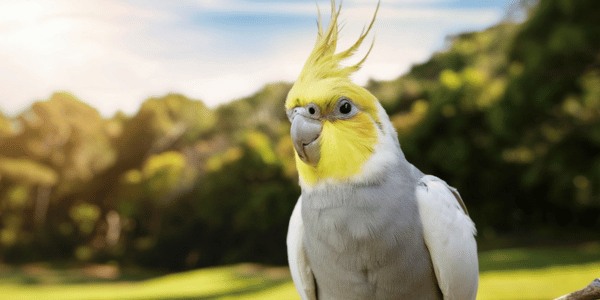
3. Cockatiel
Identification and Characteristics
The cockatiel is a type of parrot that typically comes from Australia. It also happens to be one of the most popular pets worldwide. It can easily be identified with its unique yellow face, orange cheek patches, and long pointed crest, which can rise or fall depending on its mood. In other words, the rest of its body covering is commonly gray but with some variants resulting from mutations. Most cockatiels measure 12-14 inches long, including their long tail feathers, making them small to medium-sized parrots.
Habitat and Behavior
In their natural habitats, cockatiels are usually found in open woodland, scrublands, and bushlands of Australia, where they move around in groups seeking water and food. They have good personalities because they are loving, sociable, and smart birds. They can mimic sounds, speak some words and phrases, and be gentle-natured. These traits make them famous among bird lovers who fancy keeping them as pets.
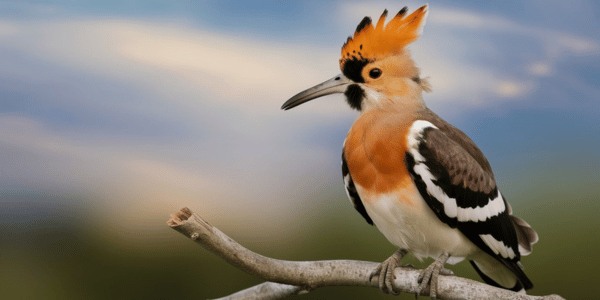
4. Hoopoe
Identification and Characteristics
This is a very attractive bird with a peculiar crest that can be spread to look like a crown. The plumage features a combination of cinnamon-brown, black, and white coloration, while the bill is long and thin enough to allow it to penetrate the ground for insects. Additionally, its broad wings are rounded, revealing an appealing pattern of stripes colored either white or black when in flight.
Habitat and Behavior
Different parts of Europe, Asia, and Africa shelter Hoopoes, which inhabit diverse ecosystems comprising semi-arid woodlands or savannas to lush grasslands or arable lands. Hoopoes are generally ground feeders, feeding alone or in pairs by probing the soil with their long bills for grubs and insects. As such, during breeding seasons, they become vociferous in oop-oop-oop calls that mark increased territorialism.
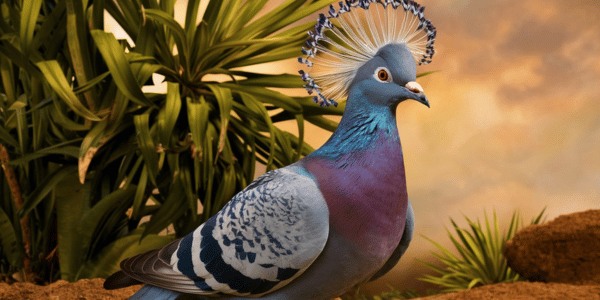
5. Victoria Crowned Pigeon
Identification and Characteristics
One of the largest pigeons on earth is known as a Victoria-crowned pigeon (Juniper & Parr 112). The bird’s head has a blue-grey crest edged by lacy white tips named after Queen Victoria herself, and this species was dedicated to its name (Heinrich et al., 2010). The rest of its body feathers have a rich hue of blue-gray coloration with chest maroon and glossy iridescence. It is a giant pigeon that gets up to 30 inches in terms of body length, making it look more royal.
Habitat and Behavior
Victoria-crowned pigeons are indigenous to the lowland rainforests of New Guinea, where tree fruits, seeds, and insects constitute their main diet (Birdlife International 2013). Despite its size, this bird is very gentle in its gait as it strolls while searching for food. Sometimes, its deep hooting sound can be heard from the far end of the forest, adding some mystic atmosphere to its dwelling place.
You May Also Like: The Ultimate Guide to Blue-and-Gold Macaws

6. Pileated Woodpecker
Identification and Characteristics
The Pileated woodpecker is one of North America’s largest woodpeckers, and it has memorable features such as black and white feathers and a bright red crest on the head (Pitelka 1982). Its body is mainly black, with large white wing patches visible during flight while striking white stripes run down its neck. This bird’s chisel-like bill enables it to bore rectangular holes through trees that provide passage for insects, especially ants, which make up an important part of its diet.
Habitat and Behavior
Pileated woodpeckers usually inhabit mature forests with numerous standing dead trees and fallen logs that act as their nesting sites or food sources (Wiebe & Moore 2008). These territorial birds are found in pairs drumming on trees loudly to demonstrate their claims over particular habitats. They are easily identifiable due to their unique calls and impressive digging work inside North American forests.
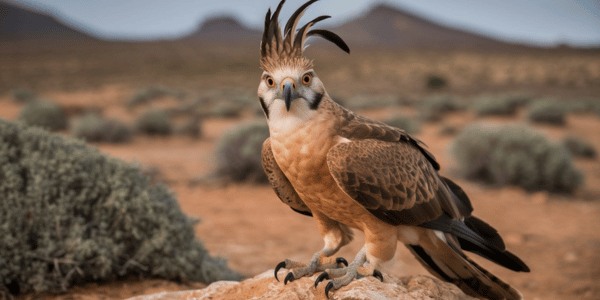
7. Crested Caracara
Identification and Characteristics
The Crested Caracara is a special bird of prey whose unusual looks and brave behavior make it stand out from the rest. It has a black cap, orange-red face skin, and a white neck and underparts, making it distinguishable and unmatchable to any other bird of prey worldwide. Its body color is mostly dark brown to black, but while flying, one can see that its wings and tail have some white markings on them. Also, this versatile predator has long legs and a strong hooked beak that are perfectly suited for scavenging and hunting.
Habitat and Behavior
Crested caracaras inhabit open areas or semi-open habitats across Central and South America, including southern parts of the United States. They are frequently seen foraging on the ground or perching on fence posts or low trees, searching for carrion, insects, and small vertebrates. Unlike most raptors, they live off whatever comes their way, which explains why they can be found in groups at places where food is available.
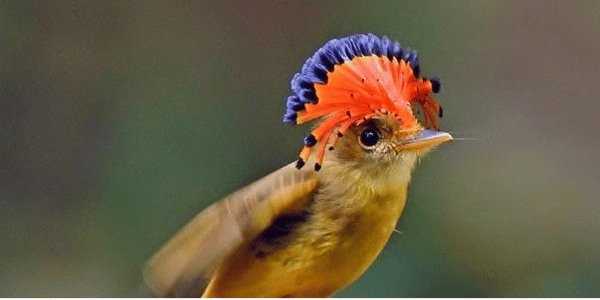
8. Royal Flycatcher
Identification and Characteristics
The Royal Flycatcher is a tiny subtle sunbird that suddenly becomes spectacular when it raises its brilliant crest up skyward. For instance, the male flies with his head up high, displaying bright red with yellow, while the female’s crest turns into subdued orange-yellow shades during certain courtship displays. These crests are only displayed during breeding season or whenever they feel excited by something around them; otherwise, you may not see these appendages at all among these birds’ populations – nothing about them suggests that they even have such beautiful headdresses.
Habitat and Behavior
The main habitats for royal flycatchers are dense forests inhabited by rivers in Central and South America. They feed themselves by catching insects that fly by them, sometimes while they are still in the air, or by picking off them from foliage. They are birds of elusive nature that remain hidden under thick bushes and are, therefore, difficult to be seen by anybody, including birdwatchers. Yet their complex courtship displays and unique breeding habits, like building long, hanging nests, have made them a point of interest for ecologists.
You May Also Like: Can Birds Eat Popcorn?
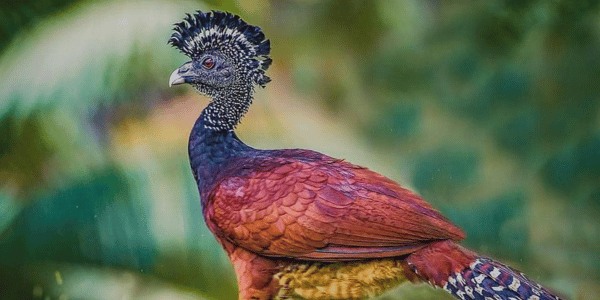
9. Great Curassow
Identification and Characteristics
The Great Curassow is a large bird that is found on the ground in tropical forests throughout Central and South America. It can be noticed by its striking plumage, which comes in black or brown colors; males are all black with white bellies, whereas females may have some rufous feathers or be almost completely black with fine cross bands. This distinct head crest consists of curled feathers stands up on both males and females heads, also they possess an enormous strong bill very often brightly colored.
Habitat and Behavior
Great curassows live in dense tropical forests where they feed on fruits and seeds as well as small animals found on forest floors. These birds tend to run away deep into the woods at any sight of danger since they hide in thickets away from prying eyes. However, despite being large-sized birds, these curassows are very nimble while moving through thickets at high-speed rates only matched by wind blowing among tree branches. Moreover, these species produce loud, mellow hooting sounds, particularly at dawn when their echoes fill rainforests.
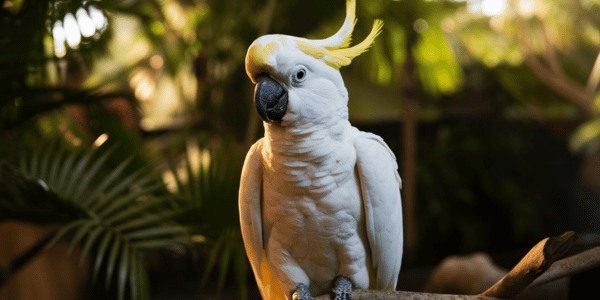
10. Sulphur-crested Cockatoo
Identification and Characteristics
The Sulphur-crested Cockatoo is a big, highly intelligent parrot from Australia and New Guinea. Its all-white feathers and the yellow crest that can be moved up or down make it easy to recognize this bird. This species has a strong, curved beak and mighty legs that allow climbing and holding things. Large crested cockatoos can grow to 20 inches long, with wingspans around 40 inches, making them among the biggest.
Habitat and Behavior
These birds are common in different types of ecosystems like forests, savannas, grasslands, and even cities, where they form big noisy flocks. Loud, raucous cries that can travel long distances are known for sulfur-crested crests parakeets. The latter have been shown to possess incredible social skills and hence learn difficult tasks and mimic human speech. Wild ones cover great distances while searching for food, such as seeds, nuts, fruits or insects.
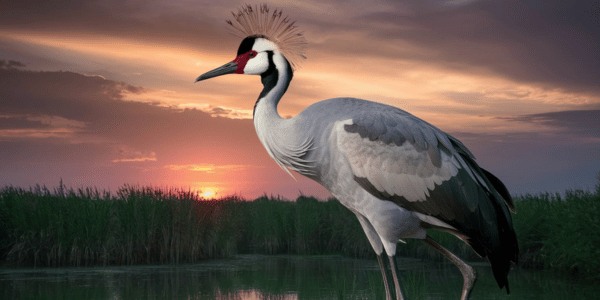
11. Grey Crowned Crane
Identification and Characteristics
Known for its beauty and graceful movements, the Grey-Crowned Crane is an impressive bird. The head usually has a golden “crown” made of stiff feathers, unlike its grey body or white wings, which come with patches of black-brown gold. Additionally, its face appears stunning; it has a wattle that is bright red with a patch on each side of a white cheek area. Male cranes stand about three feet tall, making them easily recognizable in Africa.
Habitat and Behavior
Wetlands, savannahs, and open grasslands of eastern/southern African countries are where you will likely find the Grey Crowned Cranes more commonly seen in pairs or small family groups. They bow, jump , spread their wings, etc., when celebrating love .Generally, these birds eat seeds, insects, small vertebrates, and, at times, even tiny fishes. Despite their size, crowned cranes are one of the few crane species which often roost in trees during nighttime and can fly.
You May Also Like: Beautiful Ducks You’ll Find in Spain
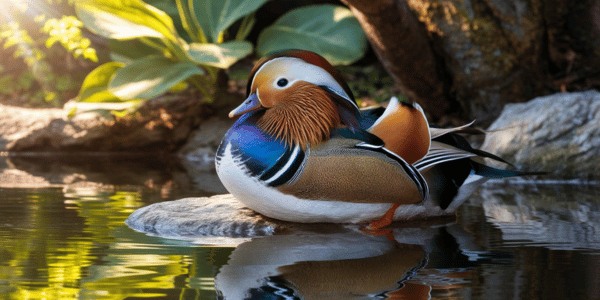
12. Mandarin Duck
Identification and Characteristics
A well-documented bird that stands out in its vibrancy is the Mandarin Duck. Males are particularly noticeable as they have bright orange “sails” on their backs, red beak, violet chest, and wings’ patterns in a white-green-blue combination on the head. The females also appear graceful but not bright with soft brown and gray colors and white eye rings.
Habitat and Behavior
Mandarin Ducks are originally from East Asia, commonly found in woody ponds or lakes with overhanging vegetation along rivers. They usually move about in pairs, especially during mating periods when males show off their colorful feathers to attract mates. Mandarin ducks are also good swimmers and fliers. They feed on plant materials, small fish, and insects. Mandarins have varied diets encompassing plants, animals, etc.
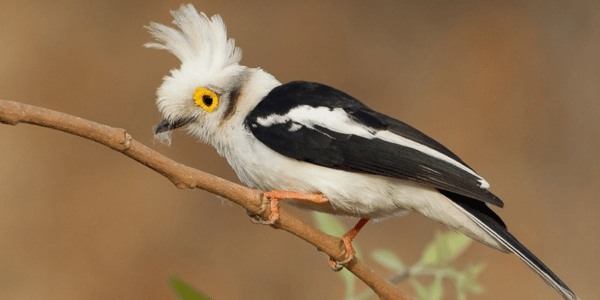
13. White-crested Helmetshrike
Identification and Characteristics
The white-crested helmet shrike is a small, gregarious bird found in sub-Saharan Africa which can be identified by its striking black-and-white coloration and characteristic crest that is white. Its body is mainly black in color with a bright white belly and a contrasting patch of white on the wings. It is characterized by the notability of the white crest on the head, which it raises when annoyed or alarmed. The piercing gaze of this bright yellow-eyed helmet shrike only emphasizes its remarkable character.
Habitat and Behavior
White-crested helmet shrikes are highly social birds, often found in large noisy groups moving together through forests or savannahs. They are known for their cooperative behavior, especially during breeding, when group members assist in rearing young ones. These birds feed on insects, spiders, and other small invertebrates. They actively forage through trees and bushes, with never-ending chattering and movement giving them away.
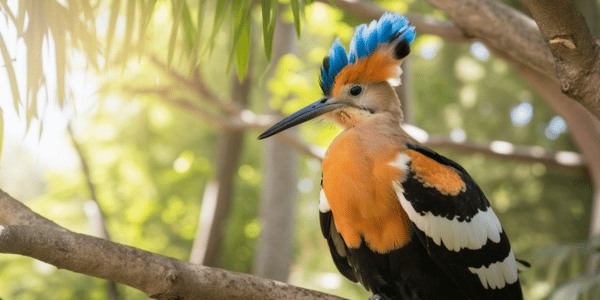
14. Eurasian Hoopoe
Identification and Characteristics
The Eurasian hoopoe is an easily recognizable bird because of its conspicuous black-and-white wing pattern, long curved bill, not to mention its feathered crest that can be raised like a fan. Warm cinnamon body color contrasts sharply with black and white wings characteristics to this bird species’ anatomy. Hoopoes have long bills adapted to probing the ground for insects whereas their wide wings make them strong fliers.
Habitat and Behavior
Eurasian hoopoes occur across Europe, Asia, and North Africa; they usually inhabit open areas with sparse vegetation, such as grasslands, savannas, or farmlands. During winter months, they are migratory over much of their range, escaping to warmer climates than where they breed from. Solitary feeders most normally observed alone or in pairs are hoopoes, which are characterized by their distinctive, soft “hoop-hoop-hoop” call. Their peculiar looks and actions make them a thrilling bird for any birdwatcher or ornithologist.
You May Also Like: The 21 Ugliest Birds: Nature’s Strange Creations
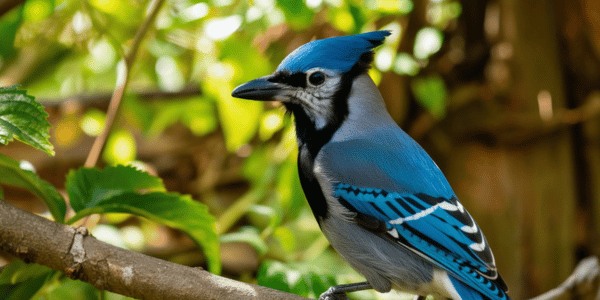
15. Steller’s Jay
Identification and Characteristics
The western parts of North America are home to Steller’s jay, a stunning blue bird with a black head and crest that stands out in contrast. The feathers on this bird’s wings, tail, and underparts are deep, rich blue, whereas sleek, glossy black color adorns its head, back, and chest. Its prominent crest gives it an audacious look and makes it one of the most recognizable birds in its range.
Habitat and Behavior
Coniferous forests and mixed forests at higher altitudes often harbor steller’s jays, which are notable for their loud vocalizations, which have many variations. They are highly intelligent birds that have been seen to rummage through campsites or yards looking for food. Steller’s jays also eat seeds, nuts, berries, insects as well as small animals; hence they fall into the omnivore category. Moreover, these birds are known for being mimicry experts since they can even imitate the calls of other birds, let alone some animals, thereby boosting their reputation for intelligence plus resourcefulness.

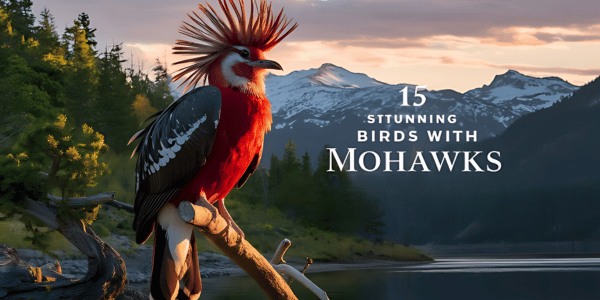





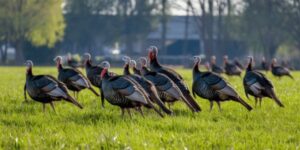

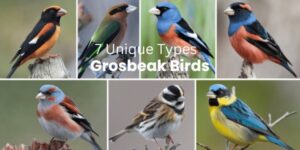
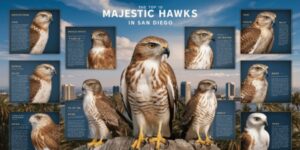
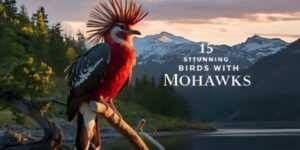
2 Responses